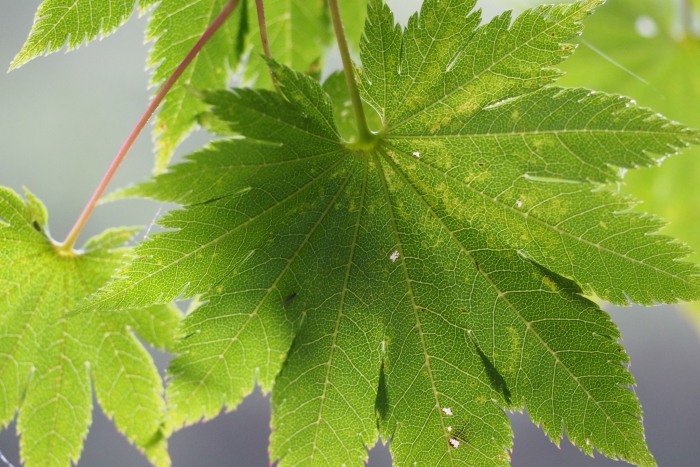Full Moon Maple
(Acer shirasawanum)
Full Moon Maple (Acer shirasawanum)
/
/

harum.koh
CC BY-SA 4.0
Image By:
harum.koh
Recorded By:
Copyright:
CC BY-SA 4.0
Copyright Notice:
Photo by: harum.koh | License Type: CC BY-SA 4.0 | License URL: http://creativecommons.org/licenses/by-sa/4.0/ | Rights Holder: harum.koh | Publisher: iNaturalist | Date Created: 2017-10-01T15:13:25-07:00 |















Estimated Native Range
Summary
Acer shirasawanum, commonly known as Full Moon Maple, is a deciduous tree or large shrub native to the mountainous regions of Japan, where it thrives in the understory of mixed forests and on forest edges. It typically grows to 8–15 meters tall with a trunk up to 50 cm in diameter. The bark remains smooth throughout the tree’s maturity. The leaves are deeply lobed, resembling a full moon, and are especially noted for their striking fall colors, which range from bright gold to orange and dark red. The Full Moon Maple blooms in spring with inconspicuous flowers; the 1 cm diameter flowers feature five dark purplish-red sepals, five small whitish petals that are soon lost, and prominent red stamens. The flowers are followed by samaras, or winged seeds, which are also ornamental.
This maple is valued for its beautiful foliage and spectacular autumn color, making it a favorite for ornamental use in gardens and landscapes. It is often used for border planting or as a feature tree in Japanese-style gardens. Full Moon Maple requires medium amounts of water and prefers well-drained soils with a slightly acidic to neutral pH. It is adaptable to full sun or part shade, but in hotter climates, it benefits from some afternoon shade to prevent leaf scorch. While generally low-maintenance, it can be susceptible to leaf scorch, aphids, and Verticillium wilt. Gardeners should be aware of these potential issues and plant in optimal conditions to minimize problems.CC BY-SA 4.0
This maple is valued for its beautiful foliage and spectacular autumn color, making it a favorite for ornamental use in gardens and landscapes. It is often used for border planting or as a feature tree in Japanese-style gardens. Full Moon Maple requires medium amounts of water and prefers well-drained soils with a slightly acidic to neutral pH. It is adaptable to full sun or part shade, but in hotter climates, it benefits from some afternoon shade to prevent leaf scorch. While generally low-maintenance, it can be susceptible to leaf scorch, aphids, and Verticillium wilt. Gardeners should be aware of these potential issues and plant in optimal conditions to minimize problems.CC BY-SA 4.0
Plant Description
- Plant Type: Tree
- Height: 16-20 feet
- Width: 16-20 feet
- Growth Rate: Slow
- Flower Color: N/A
- Flowering Season: Spring
- Leaf Retention: Deciduous
Growth Requirements
- Sun: Full Sun, Part Shade
- Water: Medium
- Drainage: Medium
Common Uses
Bank Stabilization, Bee Garden, Bird Garden, Butterfly Garden, Low Maintenance, Potted Plant, Street Planting
Natural Habitat
Mountainous regions of Japan, understory of mixed forests and forest edges
Other Names
Common Names: Shirasawa Maple, Golden Fullmoon Maple, Shirasawa-Ahorn, Shirasawalönn, Ō-Itaya-Meigetsu
Scientific Names: , Acer shirasawanum, Acer dissectum var. tenuifolium, Acer shirasawanum f. aureum, Acer japonicum f. aureum, Acer japonicum var. microphyllum, Acer japonicum f. microphyllum, Acer japonicum var. aureum,
GBIF Accepted Name: Acer shirasawanum Koidz.